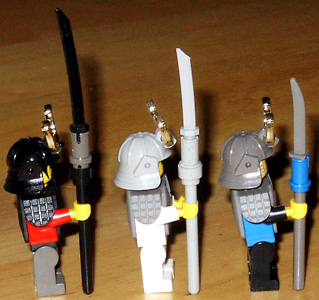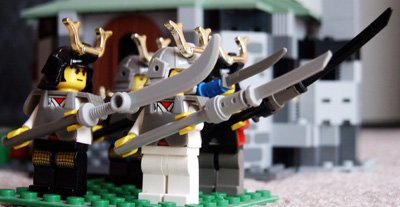The European Glaive and the Japanese Naginata are somewhat similiar weapons - basically a curved blade on a pole, so this was killing two birds with one stone.
The usual approach is to simply stick a Katana on some kind of pole with a connecting piece. There's a variety of connectors that work, but I settled on a "technic pin 1/2" (to use the BrickLink designation). It's available in light and dark gray, but not black so far as I can tell, and it gave a firm connection at both ends. The thing about the technic pin connectors is that different styles produced wildly different results depending on the part that you are trying to connect to - the one I used here works well for the parts noted, but don't assume that it is best for a spear or umbrella stand, for example.
Forgive the unmatched colors. I simply grabbed what I had handy - the massed order is not here yet.

The fig on the left is from standard unmodified pieces. A Naginata is anywhere from 6-12 feet long, the blade constituting 1-3 feet of that. Their length was usually customized for the user - women used them, too, which probably accounts for the shorter ones. So, this unmodified one falls into the long end of the scale, but the blade is really too long (it's really too long for a katana, but considering that this is one of the more accurate Lego weapons, it seems a bit picky to slight it).
Which leads into the middle fig, which uses an antenna ("bathroom plunger" style), the aforementioned technic pin, and a katana cut down so that its blade is about the same length as the standard Castles sword. This serves two functions, actually: I can always use the cut-down sword as the smaller of the two traditional Samurai swords, the wakizashi. The antenna leaves something of a bulge in the middle, but gives an otherwise pleasing proportion that I like.
The point on both a glaive and a naginata is actually more like the cutlass than a katana (both can curve more, but you can't have everything). So, taking a cue from the "Legolas" conversion done earlier, I hacked off the hand guard and this actually gives a pretty good rendition. I used a slightly shorter but less bulky wand/light sabre blade just to show how that works, but it is virtually the same length as the middle version if it is placed on the antenna piece. A Glaive is pretty much in the same range as the Naginata, 8-12 feet depending on location and era.

